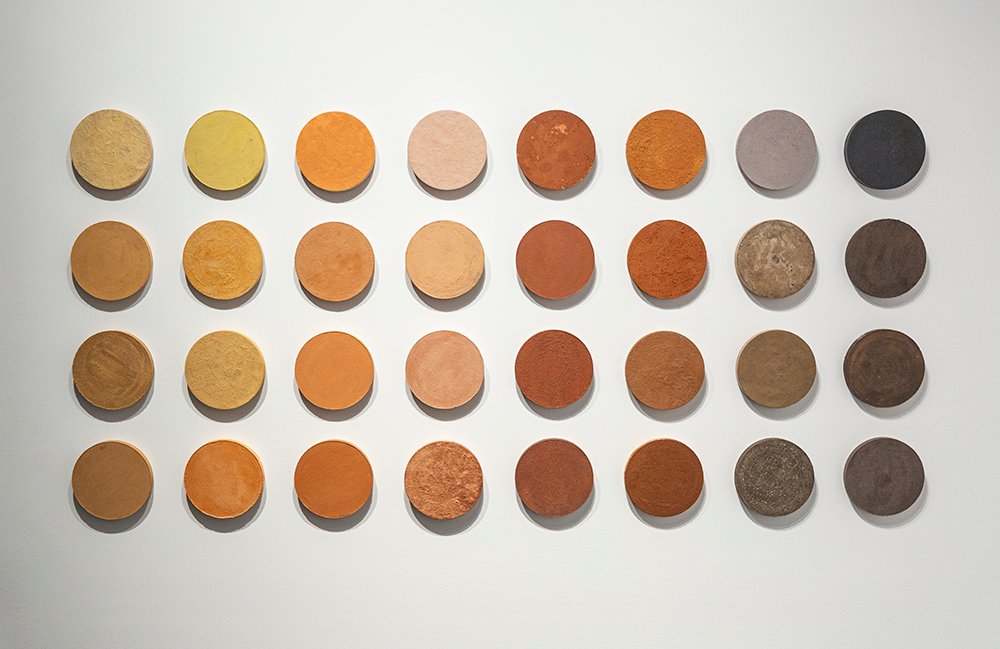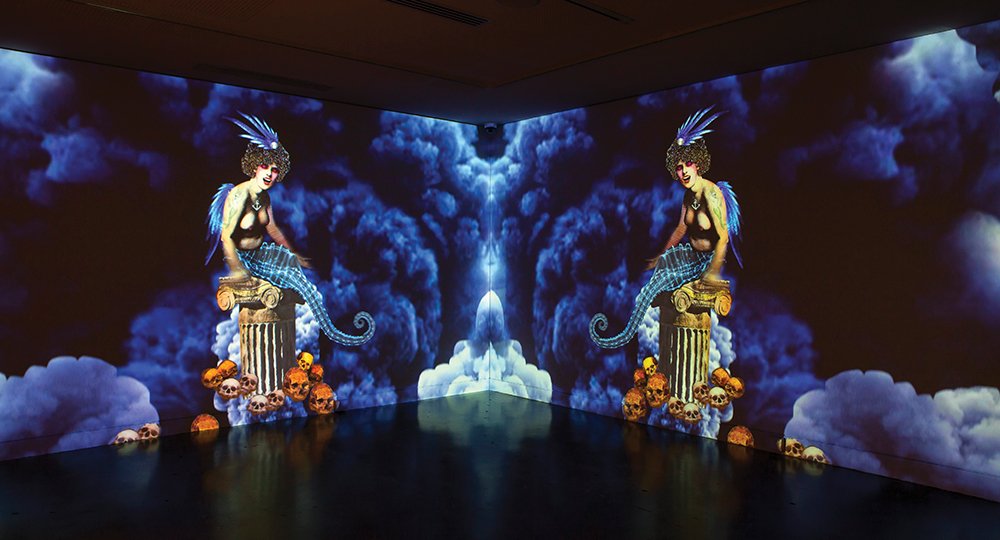Fragile Tethers: Art after floods
Karma Barnes Mapping Internal & External Terrains - Community Cartography (detail), 2023, earth pigments, bush fire charcoal and ash and flood mud samples gathered from Bundjalung, Gumbaynggirr and Yaegl Country, Northern Rivers, NSW. Photo: Yaka Ademic. Courtesy of the artist
Words by Chloe Watfern
Some things won’t change, a woman told me in a small room on Bundjalung Country, filled with other women weaving; the smell of raffia and pillows. It was raining so we couldn’t sit outside. I began to weave a circle.
We thought we trusted the bush to be there, but then fire comes, Ruth said. We thought we could turn to the river, but then it overflows. The places we take refuge don’t feel so safe. But we can count on galaxies and bacteria and stones to be around long after we are gone.
Driving my carbon-belching hatchback from one colonial settlement to another, I listened to a book about microbes under a slivered moon. Fires flanked me at one point on the road. They weren’t close enough to scare, contained, but there: the contents of my gut, and the flames.
I was on a gonzo mission to connect with galleries, artists and mental health workers in the Northern Rivers region of New South Wales. I work on a program, devised by the Black Dog Institute and the Art Gallery of New South Wales, that supports anxious kids and their parents.[1] Over eight weeks, they look at art, and then make things together in a very open-ended and process-driven way. It’s a simple formula, which really helps young families. The program is now being delivered in regional galleries across the state, in places that have been affected by climate-fuelled natural disasters.
These days, it’s impossible to find somewhere that hasn’t been scarred by climate change and its human architects. But in the Northern Rivers, they’ve seen drought, followed by the Black Summer, followed by the largest flood event in modern Australian history.[2] Living through this takes a toll. Particularly with the knowledge that the worst is yet to come.
How does art help us grapple with our fragile, precarious existences on this fragile, precarious planet? I suppose that is what I wanted to know—what I wanted to feel?—as I moved from river to mountain to river to beach.
At the Clarence Valley Council chambers, I joined the regional Youth Network meeting under a robust air conditioning unit. The icebreaker: what did you want to be when you grew up? Many of us said marine biologists, zoologists, vets. There was one poet. Adults now, none of us became what we thought we would be. I spoke about the program, Culture Dose for Kids. I spoke about art and nature—nature/culture? Smoke began to weasel its way under the front door, from Grafton’s hazy main street. Bushfires in October.
We need to smash the system, one government officer told me. I misheard: Smash. The. System. Can’t take refuge there, I supposed.
Sunset over the Clarence River, 2023. Photo: Chloe Watfern
At the Grafton Regional Gallery, I was shown the flowers growing in their cottage gardens: California poppies and African daisies under Jacaranda blossom—native to Brazil. Could we make something with them? Inside, Karma Barnes’ discs of earth pigment were collected by many hands and labelled idiosyncratically: landslide mud, flood stump, garden soil, exposed road, bush ash, 300-million-year-old Jaspilite. Originally scheduled for Lismore Regional Gallery, it was due to the damaging floods of 2022 that the exhibition migrated south to Grafton Regional Gallery. That evening, I took photos of the red haze around the sun, a feeble sphere over the Clarence. I tried not to breathe. What should I call this glistening movement of water? Boorimbah? Ngunitji? Surely not the name of a long-dead British King.
130km north, in Lismore, I didn’t even know where the river was until Tom walked me there. This is a town with its back turned to its river. Tom is a storyteller and founder of Revive the Northern Rivers.[3] He explained, the river didn’t flood the town, the town is on a river that floods. Poor wounded river. Great powerful river.
Later, I listened to recordings made by Rose Turtle Ertler of local residents speaking to their river, it began:
Dear River… father river… it’s time we all made peace with you… your veins have been clogged with the rubbish that we create, your path has been diverted, and your banks dammed to protect us from the flood plains… I am sorry, we are sorry… (4)
In the town with its back to the river, I joined the weekly collage club around a line of trestle tables set out in front of the boarded-up Lismore Regional Gallery. Last time I had visited this place, CREATION (2021)—a project led by Deborah Kelly—was on display, with collage at its core, but also so much more–‘a new religion… a faith, a gathering of intention and purpose with which to face an era when paid opinion trumps environmental evidence.’[5] Last time I had seen the Gallery it was on the news. I watched with horror from afar as flood waters breached the building.
Deborah Kelly CREATION (installation view), 2021, Lismore Regional Gallery, multichannel video. Image courtesy of the artist
Children floated and landed on chairs, ready to investigate piles of coloured paper with eager fingers. A group of committed collagists gathered at one end of the trestles, their filing systems for cuttings in tow: a briefcase, a suitcase. For some, this regular afternoon of making together is a lifeline. I rummaged through the materials. Someone had drawn a flower in red Texta on a black and white picture of a landscape. I cut it out, placed a stone on top to stop it from blowing away.
The next day, a dancer decided to take me for a walk on the beach near Pooningbah, place of the echidna. The wind was stronger by the sea, so we took shelter in a structure made from driftwood. We met because we are both mothers, both thinking deeply about the planet we have brought new life into. Geraldine said, artists care because they are attuned to what’s going on in the world around them. We care so much. Her art practice now is everywhere and nowhere: peeling vegetables, hanging clothes, placing one foot in front of another, resisting the tic-tac-toe of fast time in the end of times. Things that need urgent change need time. They need us to be slow. How can we offer or invite people to do that through our work?
Geraldine Balcazar in Time Shack, Fingal Head Beach, NSW, 2023. Photo: Chloe Watfern
Weaving again. Remember my circle? Carlie was weaving too, hers much bigger than mine, already moving upwards at the edges to form a vessel. She leads We Al-li, an organisation that provides culturally informed trauma integrated healing.[6] Founded by her mother, the organisation’s name uses Woppaburra words — We, meaning fire and Al-li, meaning water.
Carlie explained that bilateral stimulation—using both hands to do something like weaving—helps with trauma, gives the body capacity to reckon with it. When it comes to trauma from the climate crisis, she told me, we need to make space for anger and hope. That’s where we find transformation. We must remember that we are all connected. We need to connect back to places, to the river.
I’m certain that art, when used well, when recruited for slow justice and connection, is one potent tool for the transformations all of us must make in this climate era. I saw this on Bundjalung Country, in the Northern Rivers of New South Wales, in places already wounded by climate disasters. I’ve seen it elsewhere too, but that’s another story. For now, I wonder, how might we—each with our own unique vocabularies for creation—join forces? What might that look like? Where would it take us?
Another woman in the weaving group told me a story that stuck. Just after the floods, at the Northern Rivers Healing Hub where we were gathered, Anna started making something, anything, a small form. She took those beginnings home with her and continued to make, not knowing what it would become until it was there before her: a boat, with a long tether.
Diane Macdonald et al., “Culture Dose for Kids: Creating an arts engagement program for young people with mild anxiety,” Nordic Journal of Arts, Culture and Health 4,1 (2022): 1–10
Drought ended in the early Spring fires of September 2019, which continued into the devastating summer of 2019–2020. Lismore was hit by its highest water levels in recorded history in February 2022, with repeat flooding in March
Quote drawn from audio recording “DEAR RIVER” Bundjalung Country/Lismore April 2023”, Rose Turtle Ertler, MP3 audio, 22:15mins
“About”, Creation: The Project, accessed January 2024
Refer to We Al-In website for further information.
Chloe Watfern is an artist, writer and researcher. She is a Postdoctoral Fellow at the Black Dog Institute and a Research Associate of Maridulu Buydari Gumal SPHERE, where she publishes, presents and leads creative workshops about the connections between climate change and mental health.
People referred to in this text by first names are: Ruth Rosenhek, Tom Wolff, Geraldine Balcazar, Carlie (Caroline) Atkinson and Anna King. Their quotes are reconstructed from hand-written notes and reproduced here with permission.
—————————
Fragile Tethers: Art after Floods by Chloe Watfern was first published in Artlink Eco-Critical (44:1, 2024) and re-published here with permission. Artlink is a small, independent and not-for-profit publisher based in Tarntanya/Adelaide since 1981. They pay arts writers and editors across the Australia/Asia-Pacific region and highlight the work of visual artists, curators, scholars and cultural workers. You can support them by buying or subscribing to their latest thematic issue Eco-Critical (print, digital or full archive), or simply by reading, following and sharing their work. @artlink_magazine




